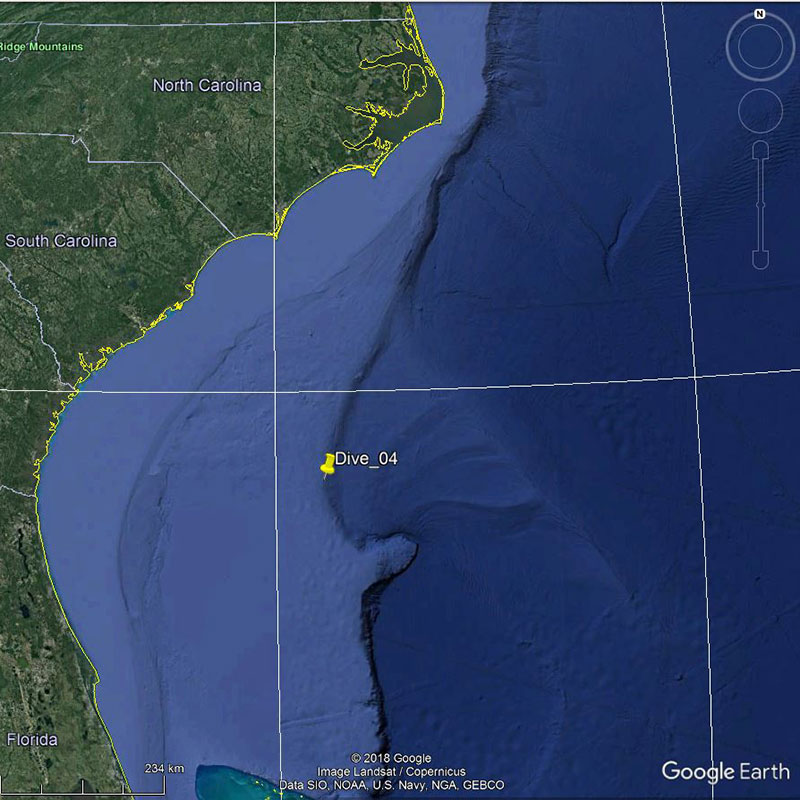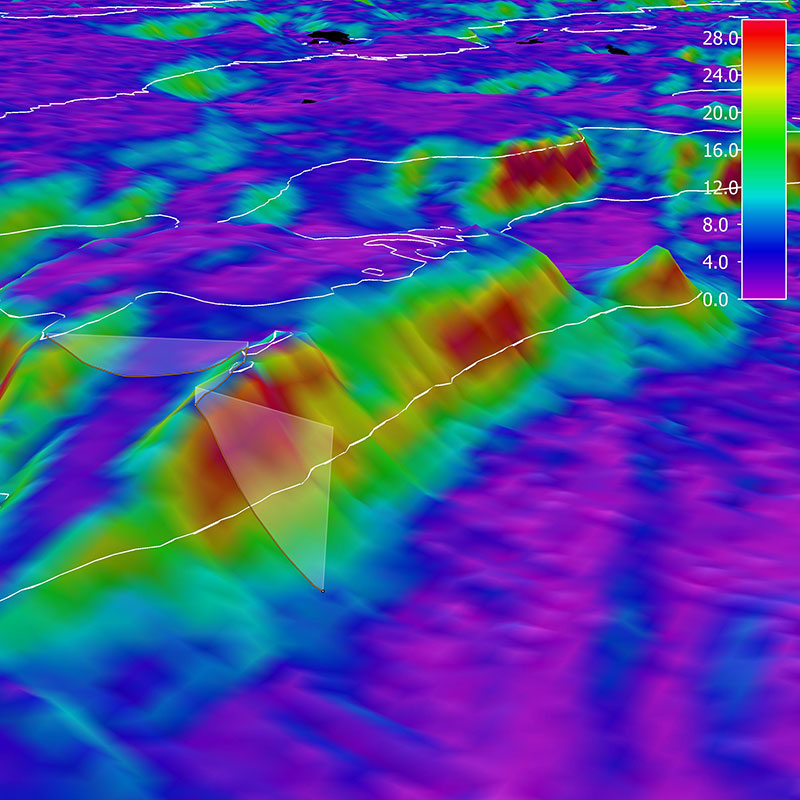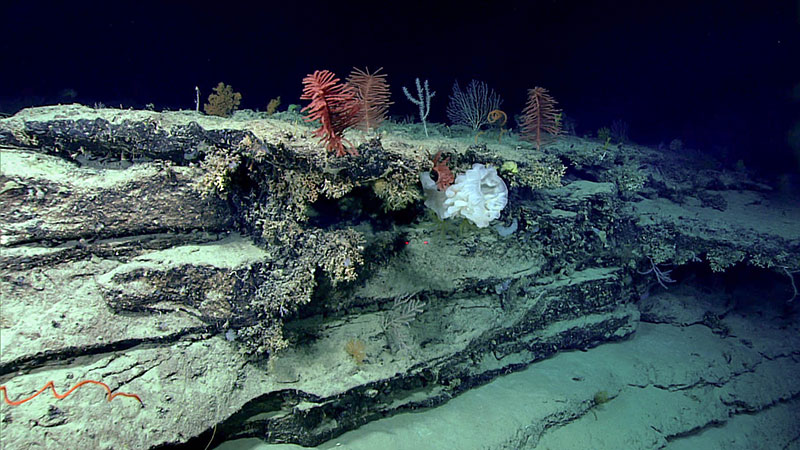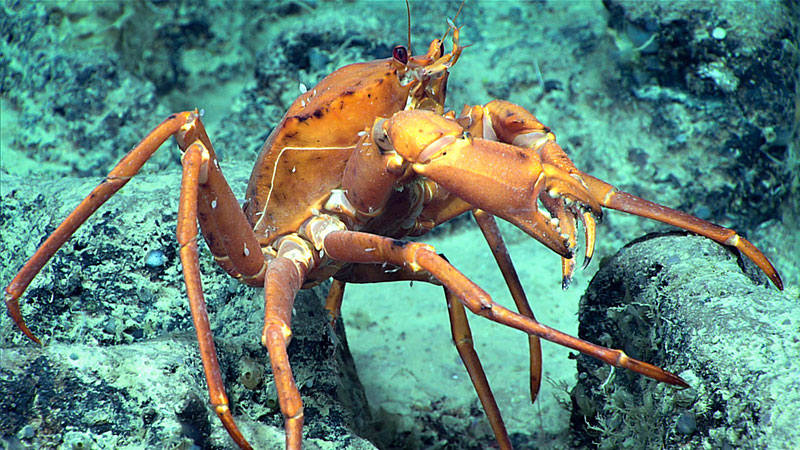Loading the player...
Dive 04: Deep Sea Dumpling
Doesn't look much like a squid does it?
Although this animal looks sort-of like an octopus, when you listen to the audio you hear the onboard scientists refer to it as a "dumpling squid." That is a local term sometimes used for species of the cephalopod order Sepiolida. They have fins and when they are sitting on or buried in the bottom, their fins are wrapped so tightly around the body that they are difficult to distinguish.
Because of their rounded bodies, sepiolids are generally known as "bobtail squids." Although called squids, bobtails have long been considered to be modified cuttlefishes that have lost the internal shell (cuttlebone). However, recent evidence from DNA sequencing indicates that they are not closely related to either squids or cuttlefishes, although they are in the broad group of 10-armed cephalopods. Bobtails have a large bacterial light organ aimed downward in the body and because of this one shallow-water "dumpling" has become very well known as a model for the study of inter-relationships between an animal and the microbes that live inside it.
This bobtail is a benthic (bottom-living) species of the subfamily Rossiinae (see http://tolweb.org/Rossiinae/20023 ). There are several genera in this area but they are difficult to identify confidently without dissecting them under a microscope.
Text contributed by Mike Vecchione, NOAA/National Marine Fisheries Service National Systematics Lab, National Museum onf Natural History
Download larger version (mp4, 17.0 MB).
Today was a very exciting dive at a site named Blake Escarpment South, with the highest density and diversity of corals so far on this expedition, especially black corals at the base, bamboo corals at the crest of the scarp, and scleractinian corals, along with several other octocorals and sponges observed throughout the day.
The remotely operated vehicle (ROV) Deep Discoverer was on the seafloor from 13:28:26 - 19:21:23 UTC. The area initially observed by the ROV consisted of broken up rock with light sediment cover. The dive started around 1,310 meters (4,298 feet), at a site with relatively low slope area with several small ridges and small, steeper, sloped scarps. Bathyal steppes observed during this dive were defined as a series of terraces that step down the continental slope from depths of approximately 1,200 - 1,400 meters (3,937 - 4,593 feet).
This dive ascended the steep slope, at over 30 degrees, of one of these bathyal steppes, then traversed along the short ridge crest, ending the dive around 1,247 meters (4,091 feet). The ROV collected several coral samples, including the first black corals sampled during the expedition, plus an unidentified sponge and various geologic samples. Some fauna seen throughout the dive included synaphoobranchid eels, sea cucumbers including one feeding, squat lobsters, a dandelion siphonophore, a flytrap anemone, deep-sea anglerfish, and a large golden crab. Stay tuned for the dive summary for a more detailed list of the biology and geology seen and sampled during this dive.
Midwater transects were completed during the ascent of this dive, from about 19:41:00 - 21:53:30 UTC. These transects were picked based on an unusual feature in the CTD (conductivity, temperature, depth) sensor during the ROV descent, where a low temperature and high oxygen water mass was present at 880 meters (2,887 feet). For each midwater transect, the ROV does set ten minute transects at 300, 500, and 700 meters (984, 1,640, 2,297 feet). The other two transects at 880 and 950 meters (2,887 and 3,117 feet) were structured to sample within and outside of the abrupt decrease in temperature and increase in oxygen. These thermocline/oxycline (950 and 880 meters) depths were accompanied by a layer of water with extremely high density of particulate matter (aka “marine snow”).
Some organisms of note were several larvaceans, a deep-sea smelt, Cyclothone (bristlemouth) fish, jellyfish, hatchetfish, siphonophores, a cydippid ctenophore, many chaetognaths, viperfish, sergestid shrimp, krill, and an amphipod. The high number and diversity of animals encountered suggest that this was a highly productivite site, and the high density of organisms and particulate matter in the water column likely support the density and biodiversity of the benthic organisms seen during the seafloor portion of the dive. Stay tuned for more deep-sea creatures during Dive 05.



